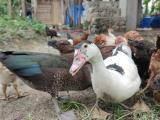Jun 4, 2012
H5N1 confirmed as Chinese boy's condition worsens
The condition of a 2-year-old Chinese boy in Hong Kong deteriorated over the weekend as his H5 flu infection was confirmed to be an H5N1 case, according to Hong Kong health officials. The Hong Kong Centre for Health Protection (CHP) reported on Jun 2 that the boy tested positive for the virus and that his condition was downgraded from stable to serious. He was in the intensive care unit at Princess Margaret Hospital and had obstructive hydrocephalus, a buildup of fluid in cavities (ventricles) in the brain. The boy is from Guangdong province in mainland China, where he first became ill on May 23. He was brought to a clinic in Hong Kong on May 26. Yesterday the CHP reported that he had visited a wet market with live birds near his home in Guangzhou in mid May. The agency said it was continuing to trace and test the boy's contacts, numbering about 80. Two of them, healthcare workers at Caritas Medical Centre, had some respiratory symptoms but tested negative for H5 infections, the CHP said. In letters issued yesterday, the agency advised physicians to pay special attention to patients who have visited wet markets or had contact with poultry in Guangzhou.
Jun 2 Hong Kong statement on case confirmation
Jun 3 CHP press release
Cambodia, Bangladesh report H5N1 outbreaks
An investigation into the recent H5N1 avian flu death of a 10-year-old Cambodian girl led to the identification of the virus in chickens and ducks in her Kampong Speu province village, according to a Jun 1 report from Cambodia's agriculture ministry to the World Organization for Animal Health (OIE). Samples obtained from local chicken and ducks were positive for the virus. The outbreak killed 564 of 1,304 susceptible birds. Authorities culled the remaining 740 poultry to curb the spread of the virus.
In related news, livestock officials in Bangladesh said H5N1 outbreaks have struck 21 of the country's 85 large poultry farms so far this year, the Gulf Times reported today. The toll the disease has taken on Bangladesh's poultry industry spurred an advisory committee yesterday to appoint an eight-member expert group to devise a plan to start a poultry vaccination program against the disease, according to the report. The group was asked to submit its recommendation within 3 days. Some countries in which the H5N1 virus is endemic, such as Vietnam, have poultry vaccination programs. However, improper follow-up and surveillance in the wake of routine immunization can mask outbreaks, further complicating disease management.
May 29 CIDRAP News Scan "Cambodia reports H5N1 death"
Study: Low-path avian flu strains spread via contact in ferrets
Two low-pathogenicity avian flu viruses infected both the upper and lower respiratory tract of ferrets, and one strain spread between animals via direct contact, according to a study in PLoS One. Georgia researchers experimentally inoculated ferrets with H1N9 and H6N1 isolates from shorebirds and found that the resulting upper and lower respiratory tract infections resulted in nasal virus shedding and pulmonary lesions but minimal morbidity. They also showed that H1N9 transmitted by direct contact between the three pairs of ferrets, despite the animals' lack of a typical avian binding site (alpha-2,3) for the viruses. (The group did not study airborne transmission.) The authors conclude, "These results demonstrate that avian influenza viruses, which are endemic in aquatic birds, can potentially infect humans and other mammals without adaptation."
Jun 1 PLoS One study



















